I Tried Every Steak at Texas Roadhouse & One Blew Me Away
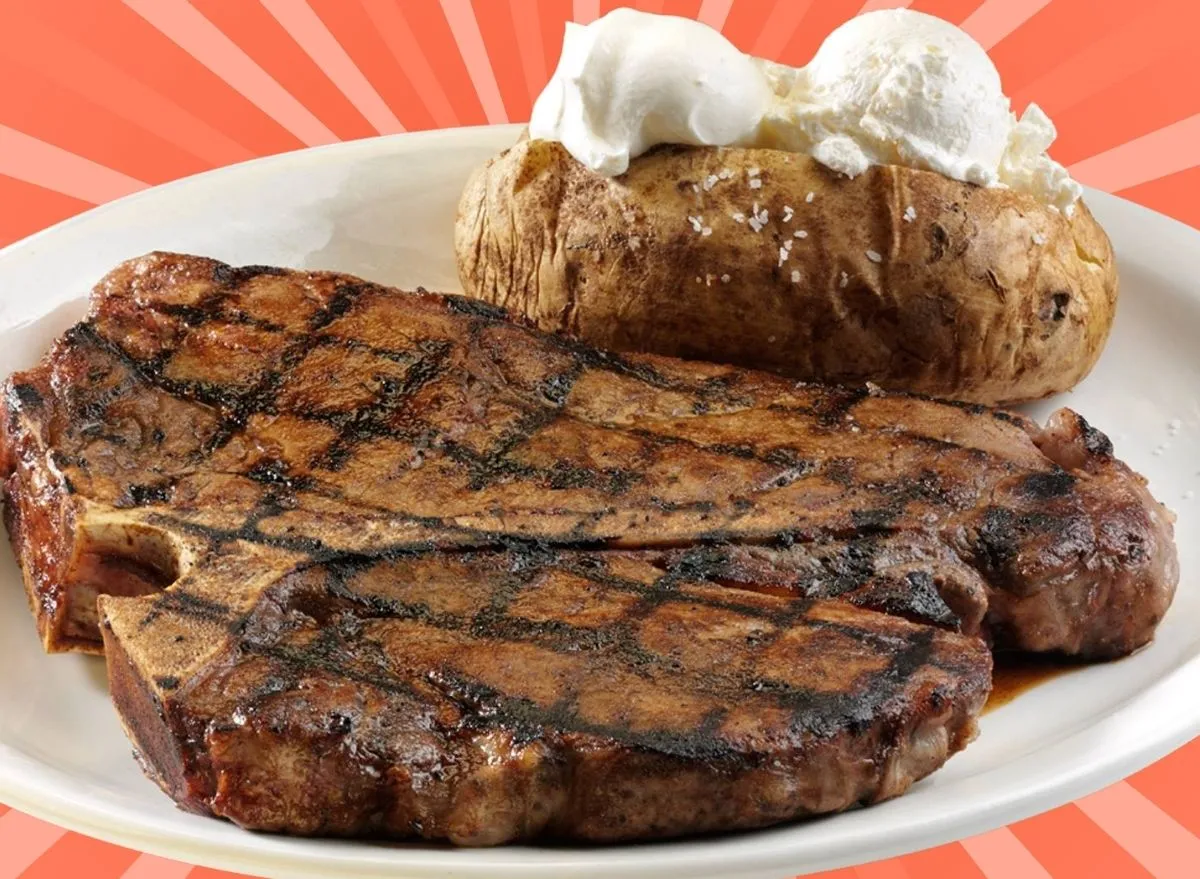
When you want a good-quality steak without all the pretense and high prices of some fancy steakhouse, there is one casual restaurant chain that currently stands above the rest. Just follow the telltale trail of crushed peanut shells to the nearest Texas Roadhouse.
The popular honky tonk-themed chain has become America’s go-to destination for budget-friendly beef, racking up over $4.6 billion in revenue last year and outselling every other major full-service restaurant brand with the lone exception of Olive Garden.
Affordability has been a big part of the attraction ever since the first Texas Roadhouse opened more than 30 years ago. In his 2021 memoir “Made From Scratch,” the company’s late founder Kent Taylor described his vision for serving the “same quality of beef” as more established steakhouse chains Outback and LongHorn, “but with price points more similar to Chili’s and Applebee’s.” Beyond its less pricey steaks, Roadhouse also quickly earned a reputation for its freebies, including complimentary bags of peanuts, baskets of fresh-baked dinner rolls, and two sides included gratis with every entrée.
Of course, dining at Texas Roadhouse today isn’t as cheap as it used to be. Amid rising beef costs and other inflationary pressures, the beloved chain has now raised its menu prices a total of three times since April 2023. At the Roadhouse location closest to me in Teterboro, N.J., most steaks now cost about $1 to $2 more than they did just six months ago. The noble bone-in ribeye, for one, has gone up $1.50 since last fall.
Yet, even with these price hikes, Roadhouse remains a good value, at least compared to its competitors. That same bone-in ribeye is still 80 cents cheaper than the nearly identical Outlaw Ribeye at the closest LongHorn location and a full dollar less than a slightly smaller version at the nearest Outback.
Having now consumed every steak on the regular menu at all three big-name casual steakhouse brands, I can confidently state that eating at Roadhouse is an overall more enjoyable experience than at either of its rivals. In contrast to LongHorn’s rustic gloom and Outback’s faux Aussie act, the vibe at Roadhouse feels more laid-back, vibrant, and contemporary American.
But, more importantly, your meal seems more wholesome. Not only does Roadhouse offer a greater sense of transparency—showcasing many of its fresh raw cuts in a display case right up front and providing a more open view of the kitchen in many locations (something its rivals don’t do)—but its cooks also consistently avoid the chronic over-seasoning that plagues the other chains’ steaks, thereby allowing the natural flavors of the meat to stand out.
Even so, not every Texas Roadhouse steak is a winner in my book. After dining at multiple locations in New York and New Jersey, here’s my definitive ranking of all 10 hand-cut steaks listed on the restaurant’s menu, listed in descending order from my least favorite to the absolute best cut of beef in the whole house.
Road Kill
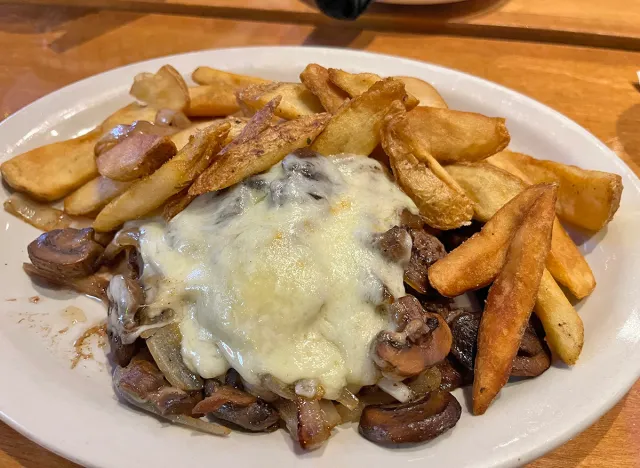
Calories: 760
Fat: 56 g (Saturated Fat: 23 g, Trans Fat: 2 g)
Sodium: 1,410 mg
Carbs: 10 g (Fiber: 3 g, Sugar: 4 g)
Protein: 55 g
At Texas Roadhouse, you can smother any steak in onions, mushrooms, gravy, and jack cheese (or any combination thereof) for a nominal surcharge (currently $2.29 near me). But, only one steak comes that way by design, piling everything on top but the proverbial kitchen sink. It’s called “Road Kill,” and it’s just as enticing as it sounds.
Basically a souped-up hamburger, minus the bun, this so-called “chop steak” is buried in so many toppings that you may struggle to find the beef underneath. At the same time, you won’t find any steak dish on the menu for less money. This plate cost me just $13.99 and came with two sides. It’s such a jumble that I didn’t quite know how to take my usual measurements, so I just didn’t bother.
The look: Wretched. This messy heap of add-ons appears to be the Texas Roadhouse answer to western New York’s infamous “garbage plate,” with a ragtag collection of slimy-looking veggies covered in a dense mass of white cheese. Somewhere under all of that is supposedly a beef patty.
The taste: Better than it looks, but still not great. Many of the individual ingredients taste fine on their own. The cheese is rich and buttery, the ‘shrooms are earthy, the onions are sweet. When I finally uncover the meat, though, the beef itself tastes quite bland and seems downright soggy under all that stuff. This strikes me as a waste of both the burger and the toppings. Try this with literally any other actual steak on the menu and the conglomeration might work better.
Sirloin
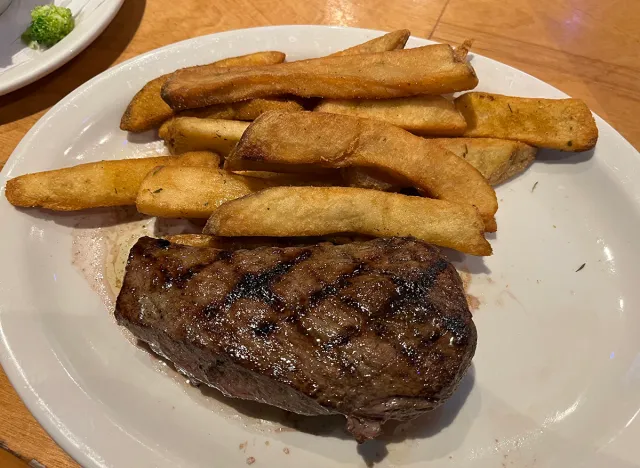
Calories: 340
Fat: 8 g (Saturated Fat: 3 g)
Sodium: 740 mg
Carbs: 5 g (Fiber: 2 g, Sugar: 2 g)
Protein: 61 g
Among the many proper steaks at Texas Roadhouse, the sirloin is the most affordable, available in 6-, 8-, 11-, and 16-ounce servings on the regular menu. (I’ve also seen cuts as big as 26 ounces in the display case up front.) Prices start at $14.49 in my area. Most recently, I opted for the 8-ounce cut for $16.99, ordered medium rare. When it arrived, the cooked meat weighed 5.9 ounces on my digital scale and measured about an inch and a quarter thick.
The look: Long and lean, streaked with dark grill marks. Inside the meat showed more pink than red in the center.
The taste: Lightly seasoned and sufficiently juicy, but chewier and less flavorful than many other steaks on the menu. This is the perfect cut to top with sautéed onions and mushrooms for added oomph. Over many visits, I’ve seen plenty of customers do just that and seem perfectly happy with it. Still, there are many other better-tasting options on the menu, provided you can afford them.
Porterhouse T-Bone
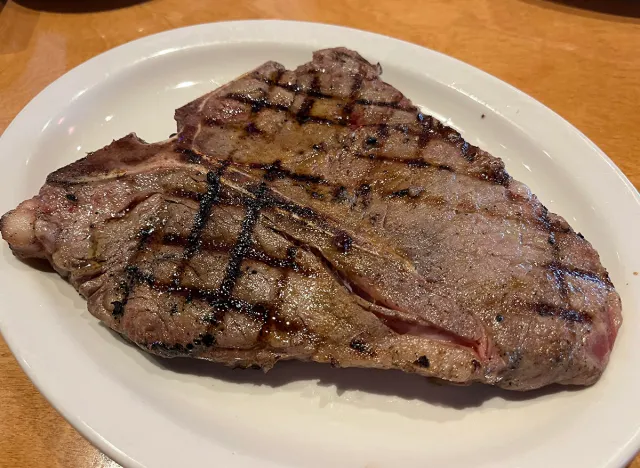
Calories: 1,040
Fat: 54 g (Saturated Fat: 24 g, Trans Fat: 3.5 g)
Sodium: 1,440 mg
Carbs: 1 g (Fiber: 2 g, Sugar: 4 g)
Protein: 139 g
Ideally, the T-bone promises meat lovers the best of both worlds. You get a tender filet and a toothsome strip all on the same plate, with the added bonus of that big honking bone in the middle, lending the meat some extra flavor. At the same time, however, that inherent polarity can sometimes make it a tricky steak to cook. So, it’s far from a sure thing.
Technically speaking, a T-bone and porterhouse are similar but slightly different cuts, yet Roadhouse treats them the same, applying both terms to this single entrée. Listed at 23 ounces, it’s the largest hunk of meat on the regular menu, and naturally, the most expensive, too. I paid $34.99 for this one and ordered it medium rare. It arrived at 19.4 ounces after cooking and measured a full inch thick. After cutting away the meat, the bone itself weighed a hefty 4.6 ounces, which translates to 14.8 ounces of actual edible beef on that plate.
The look: Massive, taking up nearly the entire 11-inch platter, but unevenly cooked. A glaring bald spot oddly stood out across a sizable swath on the strip side of the steak, as if some foreign object got between the steak and the hot grate beneath. Prodigious grill marks crisscrossed the rest of the surface, with pockets of fat and small puddles of juice in places. Inside the inconsistency is starkly evident, ranging in color from dark red to nearly purplish in spots.
The taste: Super flavorful if much more rare than I requested, especially under that bald spot on the strip side. (I hesitated to send it back for fear of encountering the opposite problem upon its return.) The filet side was more tender and mild, except at the top and bottom corners, where I encountered big gobs of soft savory fat. While the cooking temperature was variable, the seasoning seemed even-handed throughout and not too heavy.
Given the high price tag and finicky nature of this particular steak, however, I would think twice about ordering it again.
New York Strip
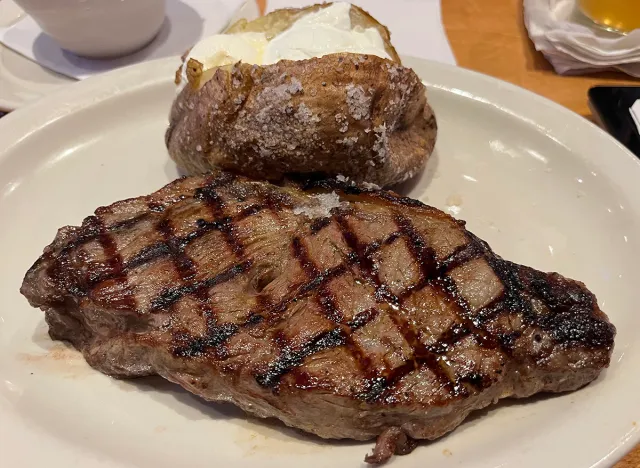
Calories: 640
Fat: 33 g (Saturated Fat: 13 g, Trans Fat: 2 g)
Sodium: 980 mg
Carbs: 1 g (Fiber: 1 g, Sugar: 3 g)
Protein:85 g
The classic New York strip remains my favorite cut to cook at home. Not to brag, but I’ve gotten pretty good at it, too. So, admittedly, I came to the restaurant with fairly high expectations. Texas Roadhouse offers the strip in two sizes on its regular menu, 12- and 16-ounces, though you can often find even bigger cuts of the same steak in the display case. The regular 12-ounce cut recently set me back $23.99. It arrived at 8.9 ounces after cooking and was about a full inch thick.
The look: Moderately sized and evenly charred across much of its surface, if a bit more black and crispy at the right tip. A slender but noticeable fat cap ran along the upper edge on the far side. Inside the strip struck a dark pink color reminiscent of watermelon.
The taste: This strip came very lightly seasoned and sufficiently juicy but with a slightly chewy texture and a much blander flavor than I anticipated. This was the only steak that I enjoyed more at LongHorn than Texas Roadhouse. And, though it pains me to say it, I believe it could use some toppings to help amplify the flavors, too.
Prime Rib
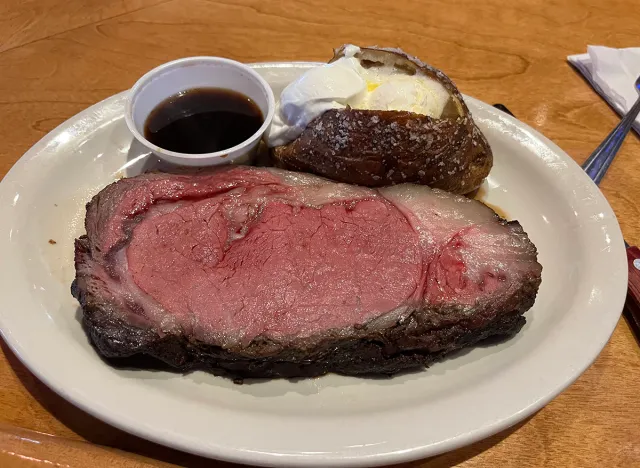
Calories: 950
Fat: 72 g (Saturated Fat: 31 g, Trans Fat: 5 g)
Sodium: 1,660 mg
Carbs: 3 g (Fiber: 2 g, Sugar: 2 g)
Protein: 74 g
Not every casual steakhouse chain offers a prime rib. LongHorn, for one, stopped serving it years ago. Both Outback and Texas Roadhouse continue to keep it on the menu, though Roadhouse notes that it’s subject to availability. It’s offered in three sizes: 12, 14, and 16 ounces. I recently ordered the 12-ounce slab for $24.99. It arrived at an even 11 ounces after cooking and measured about three-quarters of an inch thick.
The look: Rosy and fatty with dark crusty edges along the perimeter. When I turned it over, the underside appeared almost fully brown.
The taste: Surprisingly smoky. The darkened edges had an almost barbecue-like flavor, while the pinkish center tasted more mild and beefy. The texture was a tad chewy and the more I ate, the more it reminded me of a really thick bologna. The best part was the cup of au jus on the side, which was deeply brown, rich, and delicious, making this otherwise middling steak much more worthwhile. Forget the famous cinnamon butter at Roadhouse. Dunk your fresh dinner rolls (and everything else, for that matter) in this savory sauce instead.
Filet Medallions
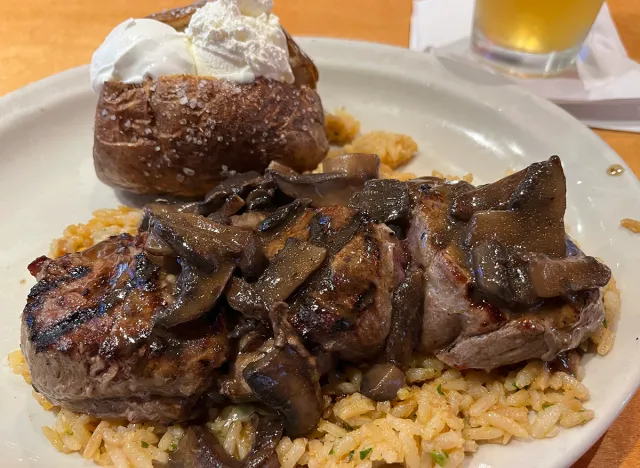
Calories: 760
Fat: 30 g (Saturated Fat: 10 g, Trans Fat: 1.5 g)
Sodium: 2,510 mg
Carbs: 56 g (Fiber: 5 g, Sugar: 5 g)
Protein: 74 g
Ask any Roadhouse employee—er, “Roadie,” as they’re called—and they’ll tell you this is one of the best deals on the entire menu. You get three small filet medallions, adding up to about 9 ounces of meat. That’s more protein than the regular 8-ounce filet but costs $4 less. It also comes drizzled with your choice of peppercorn or mushroom sauce and served atop seasoned rice. On top of all that, you also get your pick of two sides. I opted for the mushroom sauce and paid $23.49.
The look: Modest in size but plump and meaty. Each medallion came at roughly a full inch thick, weighing between 2.3 and 2.8 ounces apiece after cooking. They arrived with an ample but somewhat restrained amount of mushroom topping—far from the full-on saucy smothering of the Road Kill dish—and settled down nicely atop a bed of yellow rice flecked with green herbs.
The taste: Distinctively flame-kissed. Maybe it’s the smaller surface area, but these mini filets delivered a robust fire-grilled flavor that just didn’t come through as much with other steaks. Every morsel was superbly tender and the ‘shrooms only upped the umami factor in each bite. I also enjoyed the soft, savory rice that comes alongside. In terms of pure value, this is a tough option to beat. But from a straight-up enjoyment angle, there are a few other cuts I liked even more.
Steak Kabob
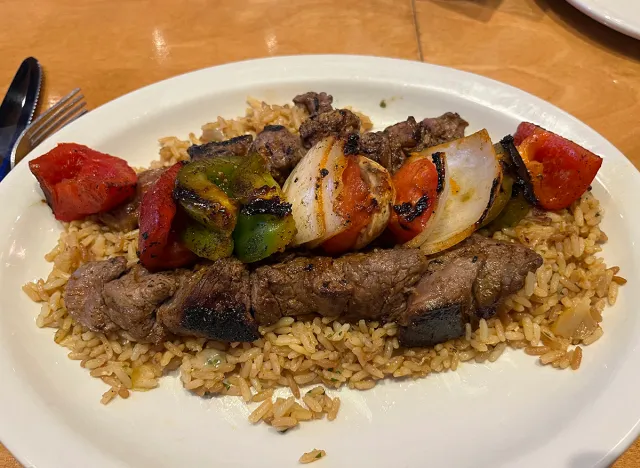
Calories: 920
Fat: 41 g (Saturated Fat: 11 g)
Sodium: 2,740 mg
Carbs: 78 g (Fiber: 4 g, Sugar: 24 g)
Protein: 58 g
Kebab probably isn’t the first word that comes to mind when you think of southwestern-inspired cooking. Frankly, I was a little surprised to see it on the Texas Roadhouse menu in the first place. What’s more surprising, though, is how much I liked it. Featuring chunks of marinated sirloin, cooked with sliced mushrooms, onions, peppers, and tomato, this dish cost me $15.49.
The look: Colorful but oddly non-skewered. Usually, I expect this sort of meat to arrive on a stick, but these beefy morsels came with no wooden or metal piercings of any kind. Instead, they were neatly arranged in two distinct rows along with hunks of vibrant-looking veggies. The beef appeared nicely browned and cut into 14 perfectly bite-sized, roughly half-ounce portions.
The taste: Sweet and succulent. Every tender morsel proved more flavorful than the last with the accompanying vegetables adding some satisfying crunch. My server refused to divulge any details about specific seasonings, only noting, “I put that marinade on everything.” I dare say this was the sleeper hit of the entire steak menu.
Dallas Filet
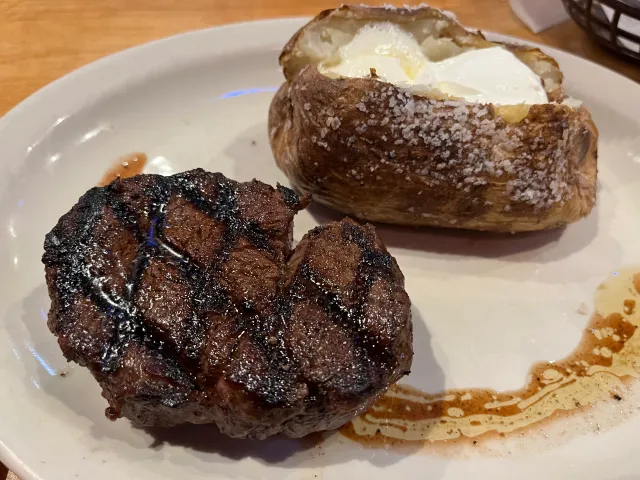
Calories: 360
Fat: 13 g (Saturated Fat: 6 g, Trans Fat: 1.5 g)
Sodium: 960 mg
Carbs: 8 g (Fiber: 2 g, Sugar: 2 g)
Protein: 60 g
The filet mignon is such a common and popular steak that you may intentionally avoid ordering it—it’s simply too predictable. If you fall into this trap, however, you may be missing out. The filet at Texas Roadhouse is a great example.
You’ll find two sizes on the regular menu: 6 and 8 ounces. I recently opted for the larger version, which cost me $27.49. It arrived at 6.1 ounces after cooking and measured a whopping inch-and-a-half—the thickest cut in this entire survey.
The look: Plump and moist. This filet came nicely browned with interlaced char marks up top and a rosy red center within. A stream of fatty juices ran down the right side of the plate, encouraging me to dig in quickly.
The taste: Superbly seasoned and supremely succulent. This cut proved incredibly soft and tasty with none-too-subtle hints of salt and smoke in its palpable char. I’ve enjoyed more tender filets in my time, but not by much, and those cuts usually cost twice as much. It would take a truly remarkable steak to top this one, and Texas Roadhouse came through with not one but two.
Ft. Worth Ribeye
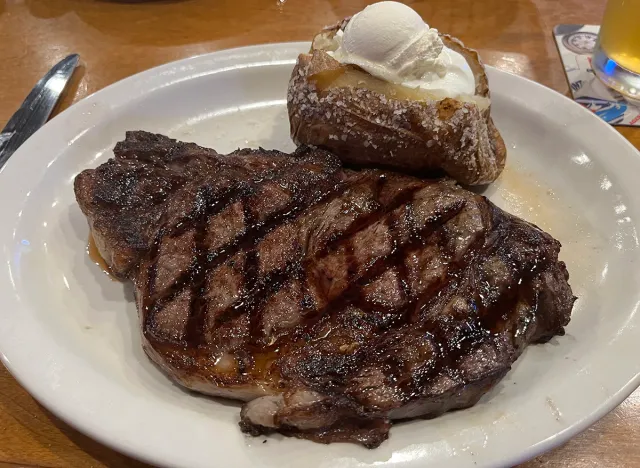
Calories: 1,280
Fat: 96 g (Saturated Fat: 40 g, Trans Fat: 8 g)
Sodium: 1,570 mg
Carbs: 16 g (Fiber: 5 g, Sugar: 3 g)
Protein: 103 g
A true steak lover’s steak, the ribeye is highly prized for its ample marbling, making it reputedly one of the most tender and juicy cuts around. Texas Roadhouse offers this tempting steak in three sizes on the regular menu: 12, 14, and 16 ounces. And, of course, you may spot even larger slabs in the display case, upwards of 24 ounces or bigger. The 16-ounce cut recently cost me $30.99. It arrived a little lighter than expected at 10.4 ounces after cooking and just a hair below the inch-thick mark.
The look: Expansive and exquisite. This wide-bodied steak shimmered with juiciness across its entire, uniformly seared surface, while inside it revealed a lush deep pink.
The taste: Rich and robust. The mouthwatering ribeye was everything you’d expect it to be: meltingly tender, expertly seasoned, and practically dripping au jus. I hardly had to chew as each slice dissolved faster than the one before. As delectable as it was, however, there was one cut that proved even more ambrosial.
Bone-In Ribeye
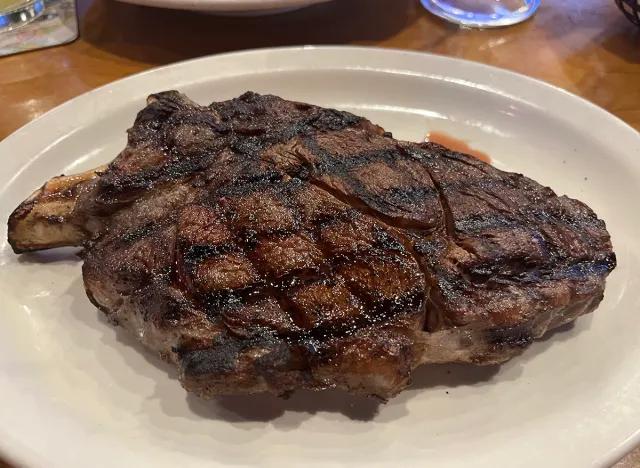
Calories: 1,480
Fat: 101 g (Saturated Fat: 44 g, Trans Fat: 10 g)
Sodium: 1,720 mg
Carbs: 20 g (Fiber: 4 g, Sugar: 4 g)
Protein: 143 g
The only thing better than a restaurant-quality ribeye, at least in my view, is a bone-in ribeye. Diehard meat enthusiasts will tell you that marrow from the bone melts into the muscle fibers during cooking, making it more buttery and delicious. I don’t claim to know the exact science behind this. I just know it works. I’ve ordered the bone-in ribeye at Texas Roadhouse several times now, and it’s always satisfying.
Most recently, this 20-ounce cut cost me $32.99 in East Meadow, N.Y. (Occasionally, you’ll find bigger versions, 24 ounces or more, inside the display case.) It weighed 15.8 ounces after cooking and stood a full inch thick if not more. After consuming the whole thing, the whittled-down bone weighed in at 3.6 ounces, which translates to over 12 ounces of pure meaty bliss.
The look: Immense, if not quite porterhouse-level enormous. The hulking ribeye arrived beautifully and consistently charred outside while striking a luxuriant red color internally.
The taste: Just as luscious as ever. Forget the oft-used phrase “falling off the bone.” This meat was so tender and juicy it was practically falling away from itself. I love the way its moist, melty red center contrasted with the salty exterior crust in every memorable bite.
This full-flavored steak requires no sauce, no toppings, no accouterments of any kind. It’s hands-down the best-tasting steak in the entire Texas Roadhouse repertoire—if not the whole casual dining world altogether.
Why Trust Eat This, Not That!?
Eat This, Not That! is committed to creating high-quality content that you can trust to be accurate, properly researched, routinely reviewed, and updated with the latest information. Our writers, editors, and medical and/or certified experts consider this to be an unwavering promise we make to our readers in the pursuit of delivering impactful and meaningful content.









